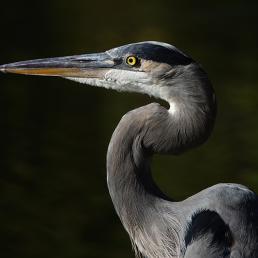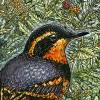

Join BirdNote tomorrow, November 30th!
Illustrator David Sibley and actor H. Jon Benjamin will face off in the bird illustration battle of the century during BirdNote's Year-end Celebration and Auction!
Unlike mammals, birds have no external ear structures. Their ear openings are hidden beneath feathers on the side of the head, just behind and slightly below the eyes. (It's easy to imagine where this House Finch's ear is, isn't it?) In mammals, the external ear structure helps funnel sound in, and it’s crucial for figuring out where a sound is coming from. Birds, too, can locate where a sound comes from, even without external ears. But how? Recent research on crows, ducks, and chickens suggests that it is the shape of a bird’s head that holds the key.
Today’s show brought to you by the Bobolink Foundation.
BirdNote®
Birds Lack External Ears
Written by Bob Sundstrom
This is BirdNote.
[Kadebostany]
Ask any child to draw a bird, and they’ll likely draw a head with eyes and a beak. But no ears. Because unlike mammals, birds have no external ear structures. Their ear openings are hidden beneath feathers on the side of the head, just behind and slightly below the eyes.
In mammals, the external ear structure helps funnel sound in, and it’s crucial for figuring out where a sound is coming from. Birds, too, can locate where a sound comes from, even without external ears. But how?
Recent research on crows, ducks and chickens suggests that it is the shape of a bird’s head that holds the key. In fact, the head does the same job for birds that the external ear does for humans. It has slightly oval contours, and when sound waves reach it, some bounce off, some are diffracted or bent out of shape, and some pass right through. These sounds that go right through are registered by the opposite ear.
By measuring how loud the sounds are in both ears, the bird is able to identify whether a sound is coming from above it or below it. And visual input is extremely important too, helping the bird get an all around impression of the world. So it’s able to assess whether there’s a predator nearby. Or not.
For BirdNote, I’m Michael Stein.
###
Bird sounds provided by The Macaulay Library of Natural Sounds at the Cornell Lab of Ornithology, Ithaca, New York.
Music: Kadebostany – ‘Castle In the Snow’ – Kadebostany 2014
Ambience – NatureSound FX #84 ‘Prairie Morning Birdsong’ recorded by Gordon Hempton of http://www.quietplanet.com
BirdNote's theme music was composed and played by Nancy Rumbel and John Kessler.
Producer: John Kessler
Executive Producer: Dominic Black
© 2016 Tune In to Nature.org July 2016/2020 Narrator: Michael Stein
ID: ear-01-2016-07-22 ear-01
key reference: http://earthsky.org/earth/how-birds-get-by-without-external-ears





